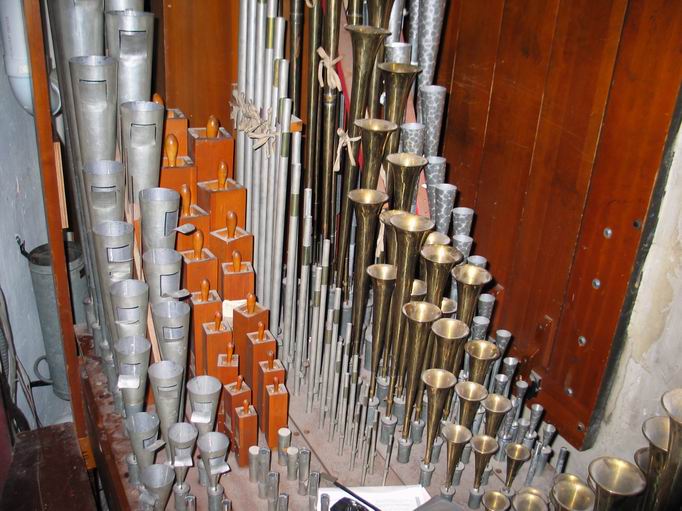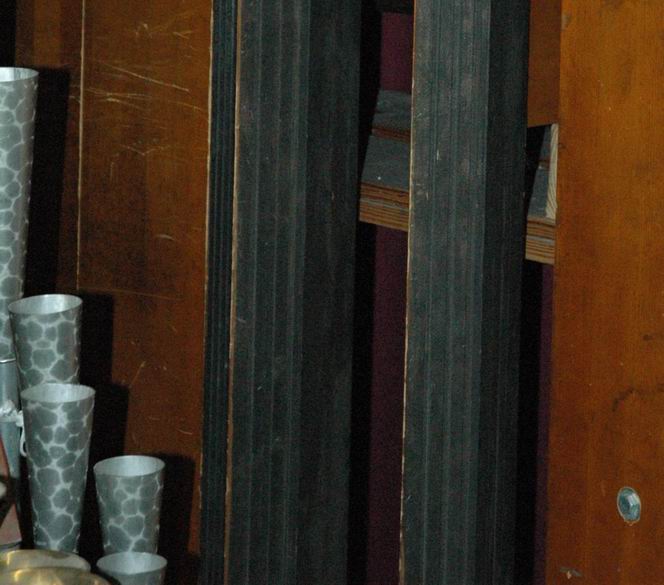Solo Chamber Photos
This page takes you on a tour of Solo Chamber for the Wurlitzer Theatre Organ as installed at the Alabama Theatre, Birmingham, Alabama. The orange cone is used as a (moving) reference point to help the viewer see the relationships amongst the pictures as the camera is moved through a chamber.
.

Standing at the entrance to the Solo Chamber from the dressing room, the 16' Tibia lower chest (C# side) is on the left and the lower solo chest is in the background. [PhotoCredit: Sabrina Summers]

Standing just inside the Solo Chamber entrance. You see 16' Tibia lower chest (C# side) on the left and the lower solo chest on the right (Tuba Mirabilis, Solo Tibia, Solo String, Trumpet, and English Post Horn). [PhotoCredit: Sabrina Summers]

Standing close to where the orange cone was, at the end of the entrance-walkboard, you see the 16' Tibia lower chest (C# side) on the left and the lower solo chest on the right (Tuba Mirabilis, Solo Tibia, Solo String, Trumpet, and English Post Horn). [PhotoCredit: Sabrina Summers]

Looking down the walkboard between the 16' Tibia lower chest (C# side) on the left and the lower solo chest on the right. [PhotoCredit: Sabrina Summers]

Standing on the walkboard behind the lower solo chest. The first set of lower-level swell shades are on the right, with a walkway running between these and this chest. The ranks (R to L) are Post Horn, Trumpet, Solo String, Tibia, and Tuba Mirabilis. [PhotoCredit: Larry Donaldson]
If you look closely at the photo above, you'll see an electric heater shaped like a section of stove pipe. Each chamber has several thermostatically controlled electric heaters used to keep the organ pipes from getting too cold in the winter.

Standing where the orange cone was and looking back towards the entrance (the steel door frame is visible at the end of the entrance walkboard). To the left of that walkboard is the Solo Tibia and Tuba Mirabilis with the Tuba Mirabilis 8' offset chests in the background. [PhotoCredit: Sabrina Summers]

Retracing our steps, and standing at the end of the solo chamber entrance walkboard, turning to the right and facing towards the auditorium wall of the chamber, is another walkboard, with Tuba Mirabilis and manual Tibia regulators underneath. [PhotoCredit: Sabrina Summers]

Looking up, this walkboard passes between the 8' Solo String and the Tuba Mirabilis offset chests. [PhotoCredit: Sabrina Summers]

A better view of the six 8' Tuba Mirabilis wood pipes in the background and the 12 unison length metal pipes in the foreground, ending with tenor F. The Uniflex output boards can be seen on the far left. [PhotoCredit: Sabrina Summers]

Standing where the orange cone was, looking back to the entrance walkboard, with the Tuba Mirabilis offset on the left, Solo String offset on the right, and C# side of the 16' Tibia along the wall ending at with 8' D#. [PhotoCredit: Sabrina Summers]

Standing where the orange cone was, looking along the auditorium wall of the chamber (swell shades on the right), the (Brass) Trumpet and English Post Horn ranks are more visible, and the Vox Humana is barely visible at the back of the picture. [PhotoCredit: Sabrina Summers]

Two swell shades propped open to show their edges. The shutters are made with their edges at an angle to seal better for middle frequency sound, with grooves cut in the edges to trap the high frequency sound from getting through when closed. Low frequency pitches are not attenuated as much as middle and high frequencies, and because of the characteristics of human hearing, the audience perceives all frequencies to have the same volume. This is similar to the "loudness" control on a high quality sound system. [PhotoCredit: Sabrina Summers]

On the walkboard between the Post Horn and the swell shades. The two chests in the background are the Harmonic Flute (top) and the Vox Humana. [PhotoCredit: Sabrina Summers]

Harmonic Flute (top) and Vox Humana. They speak through the second set of lower-level swell shades for the Solo Chamber. Note the wind line at the top of the picture, providing wind for the instruments on the second level of the Solo chamber. [PhotoCredit: Larry Donaldson]

Standing at the end of the walkboard and turnging around to see where we've been. The entrance door frame (with the dressing room square-tile floor) is visible on the right-side of the picture. The auditorium wall of the chamber is on the left, and some of the computer output boards are visible on the left-side of the picture. The lower solo chest (English Post Horn, Trumpet, Solo String, Tibia, and Tuba Mirabilis) is visible with the 8' Solo String in the background. [PhotoCredit: Sabrina Summers]

Another picture of the lower solo chest (English Post Horn, Trumpet, Solo String, Tibia, and Tuba Mirabilis). [PhotoCredit: Sabrina Summers]
Once we reach the end of the walkboard in front of Post Horn on the lower Solo chest, we have to swing 90 degrees over to the left and climb up/down a wooden vertical ladder attached to a rectangular cross-section, wooden, Wurlitzer vertical windline (it supplies the lower and upper Solo chests).
The ladder goes up to the second level of the Solo Chamber, the one being supplied by the round windline in the Harmonic Flute/Vox Humana picture above. If we continued to the top of the ladder, we can get to the double-stacked upper Solo chest.
The ladder goes down to the back-front-lower corner of the Solo Chamber.

A closer view of one of the thermostatically controlled electric heaters installed in 1927 in an attempt to keep the tempatures within the chamber from getting too low during winter because of outside wall heat losses. [PhotoCredit: Sabrina Summers]

Standing on the floor in the back-front-lower corner of the chamber, in front of the Vox Humana, looking back at the walkboard used to get here. The ladder used to climb to the middle level is on the right-side of the picture. [PhotoCredit: Sabrina Summers]

Standing at the edge of the middle level in the percussion area of the solo chamber, looking down on the ladder and the lower swell shades. The lower solo chest is on the right-side of the picture. [PhotoCredit: Sabrina Summers]

The Crash Cymbal and the Acme Siren, with a small amount of the Train Whistle visible. [PhotoCredit: Sabrina Summers]

The view to the right after climbing up to the middle level, looking towards the far wall of the chamber. The ladder on the right-side of the picture is used to access the upper level of this multiple-stack of tuned percussion. The end of the piano is behind the ladder. The Marimba Harp (two levels) and the tuned Sleigh Bells can be seen on the left. [PhotoCredit: Sabrina Summers]

Looking a little lower, the step up to the walkboard that runs in front of the piano is visible. The Marimba Harp (two levels) and the percussion regulator can be seen on the left. [PhotoCredit: Sabrina Summers]

The piano. This is the original piano installed by Wurlitzer. However, it has had its pneumatic action replaced with Wurlitzer electric solenoids (which don't work that well). Visible along the far wall of the chamber is the 8' Horn Diapason offset chest. [PhotoCredit: Sabrina Summers]

Opposite the piano is the Marimba Harp (two levels), with the Sleigh Bells visible at the top-left of the picture. Still visible along the far wall of the chamber is the 8' Horn Diapason offset chest. [PhotoCredit: Sabrina Summers]

A close-up view of the Glockenspiel/Orchestra Bells, mounted on a rack above the piano. [PhotoCredit: Sabrina Summers]

Mounted above the Glockenspiel, on the rack above the piano, is the 8' Tibia offset. [PhotoCredit: Sabrina Summers]

After climbing up the ladder to reach the walkboard in front of the upper tuned percussions, we see the Ford Horn, the Tambourine, and the Sand Block (air blowing on a sheet of tin). The tops of the 8' Horn Diapason can be seen in the background. [PhotoCredit: Sabrina Summers]

Standing on the upper tuned percussion walkboard, looking back towards the entrance door wall, we see all three levels of the first stack of chests visible from the entrance to the chamber. Both one lower and one upper sets of the swell shades are visible on the left-side of the picture. The middle level chamber floor is at the bottom of the picture, and the modern steel ladder to the Penthouse is at the right-side of the picture. The upper solo chest contains the Kinura, Orchestral Oboe, Quintadena, Solo String Celeste, and brass Saxophone. [PhotoCredit: Sabrina Summers]

Standing on the upper tuned percussion walkboard, looking back towards the entrance door wall, we see the five-rank upper solo chest speaking through one of the upper sets of swell shades (Kinura, Orchestral Oboe, Quintadena, Solo String Celeste, and brass Saxophone). [PhotoCredit: Sabrina Summers]

Standing on the upper tuned percussion walkboard, looking across and up to the solo chamber Penthouse area, added to house the Lieblich Flute, Horn Diapason, Oboe Horn, and metal 16' Diaphone. [PhotoCredit: Sabrina Summers]

After climbing the Penthouse ladder and stepping off onto the floor of the Penthouse, we can turn around and see across to the upper tuned percussion walkboard where the previous pictures were taken. The Bass Drum/Kettle Drum is on left-side of the picture with the small scale Xylophone above it and the tuned Sleigh Bells below. The Glockenspiel and 8' Tibia are above the piano on the right. [PhotoCredit: Sabrina Summers]

Having advanced into the Penthouse from the ladder (not visible, but just past the plywood access door), we see the 8' Lieblich Flute offset which speaks through the low gap between the Penthouse wall and floor, pointing towards the upper level swell shades. [PhotoCredit: Sabrina Summers]

Under the plywood access door, between the 7" percussion windline and the access ladder, is the 4' treble extension of the Horn Diapason. A few pipes of the the upper solo chest can be seen below. The upper solo swell shades can be seen in the background. [PhotoCredit: Sabrina Summers]

Looking out and down through the gap between the Penthouse front wall and the floor, we see the upper solo chest (brass Saxophone, Solo String Celeste, Orchestral Oboe, and Kinura) with the upper solo swell shades in the background. Notice the end of an I-Beam that had to be removed before Wurlitzer could install the organ. [PhotoCredit: Sabrina Summers]

Upper solo chest on the left, tops of the 8' Tuba Mirabilis on the upper right, and the tops of the 16' Tibia in the near foreground. [PhotoCredit: Sabrina Summers]

Looking backwards in the Penthouse towards the access ladder (find the tennis ball at the top of the ladder), the added penthouse solo ranks (Oboe horn, Horn Diapason, and Lieblich Flute) are on the left-side of the picture with the Solo II regulator below. [PhotoCredit: Sabrina Summers]

The solo penthouse with the 16' Ophicleide and metal 16' Diaphone on the left and the three rank Solo II chest on the right (Oboe Horn, Horn Diapason, and Lieblich Flute). [PhotoCredit: Sabrina Summers]

The bottom of the 16' Ophicleide is to the left of the metal 16' Diaphone. [PhotoCredit: Sabrina Summers]

The metal 16' Diaphone on the left with the Oboe Horn on the right. [PhotoCredit: Sabrina Summers]

The 16' Ophicleide resonators in the back corner of the solo Penthouse. [PhotoCredit: Sabrina Summers]
This concludes our picture tour of the Solo Chamber at the Alabama Theatre.
(Return to Top)